Recommended route for touring the Seven Lucky Gods of Minato
Print
- STARTScan 2D Code
to open in mobile. 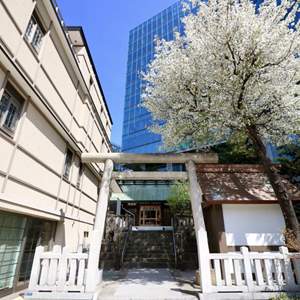 1.Ryusa Shinmei Miya Tenzu ShrineThis shrine is a company that continues from the Nanbokucho era (year 1384). It is called "Dragon Light" from the story that the Dragon gave the lantern Akira from the Shinagawa offing every night, and "Ryuakari" is heard, and this ground is called "Ryusa (Ryu)", and the name of the shrine was called "Ryusa Shinmei gu". In addition, we are enshrines the seven lucky gods Fukurokuju of the Ichifuku Inari Shrine of Suesha. Fukurokuju is open niche only on the third of the new Year.Directions
1.Ryusa Shinmei Miya Tenzu ShrineThis shrine is a company that continues from the Nanbokucho era (year 1384). It is called "Dragon Light" from the story that the Dragon gave the lantern Akira from the Shinagawa offing every night, and "Ryuakari" is heard, and this ground is called "Ryusa (Ryu)", and the name of the shrine was called "Ryusa Shinmei gu". In addition, we are enshrines the seven lucky gods Fukurokuju of the Ichifuku Inari Shrine of Suesha. Fukurokuju is open niche only on the third of the new Year.Directions 2.Sakurada ShrineSakurada Shrine moved to the temporary reservoir after it was erected in Kasumigaseki, and it seems to have moved to the current location in the year Kan'ei. In 1945, we were involved in war damage, but we rebuilt it in 28 years.Directions
2.Sakurada ShrineSakurada Shrine moved to the temporary reservoir after it was erected in Kasumigaseki, and it seems to have moved to the current location in the year Kan'ei. In 1945, we were involved in war damage, but we rebuilt it in 28 years.Directions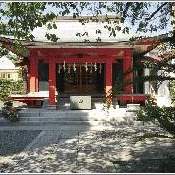 3.Hikawa Shrine (Motoazabu)Hikawa Shrine has been in the vicinity of the solitary pine in the north about 300m from the current location, and then relocated to the current location in Manji year (1658-61). It is said that it was one of Edo Hikawa Nansha in Azabu Township total Guardian. "Bishamonten" is enshrined to fulfill the great application, except for plague and calamity.Directions
3.Hikawa Shrine (Motoazabu)Hikawa Shrine has been in the vicinity of the solitary pine in the north about 300m from the current location, and then relocated to the current location in Manji year (1658-61). It is said that it was one of Edo Hikawa Nansha in Azabu Township total Guardian. "Bishamonten" is enshrined to fulfill the great application, except for plague and calamity.Directions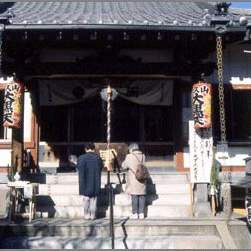 4.DaihojiDaihoji used to hold a festival for the Daikokuten (a Japanese deity) on the "Nenohi" (day of the rat), but this no longer takes place. The slope in front of the temple is called the Daikokuten-saka (slope of the Daikokuten) named after the Daikokuten enshrined in the temple. At Daihoji, which is known by local residents as the "solitary pine tree of Lord Daikoku", and it enshrines Daikokuten who is said to give visitors good luck and fortune. During the Setsubun festival, the temple holds a grand bean-throwing event.Directions
4.DaihojiDaihoji used to hold a festival for the Daikokuten (a Japanese deity) on the "Nenohi" (day of the rat), but this no longer takes place. The slope in front of the temple is called the Daikokuten-saka (slope of the Daikokuten) named after the Daikokuten enshrined in the temple. At Daihoji, which is known by local residents as the "solitary pine tree of Lord Daikoku", and it enshrines Daikokuten who is said to give visitors good luck and fortune. During the Setsubun festival, the temple holds a grand bean-throwing event.Directions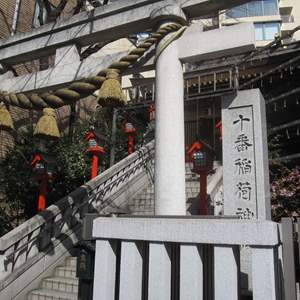 5.Juban Inari ShrineThe 2 shrines of Suehiro Shrine and Takecho Inari Shrine merged after the war and it was renamed Juban Inari Shrine. The original shrine was said to have been founded more than a millennia ago. As it was conferred with the Amulet of Fire Protection from the legend of the Frog Pond, the frog talismans are very popular. In November, they have the Festival of the Rooster, the only one in Minato district, and many people come looking for rakes. In the Pilgrimage of the 7 Gods of Maritime Fortune during the New Year, it becomes a pilgrimage site for the Treasure Ship.Directions
5.Juban Inari ShrineThe 2 shrines of Suehiro Shrine and Takecho Inari Shrine merged after the war and it was renamed Juban Inari Shrine. The original shrine was said to have been founded more than a millennia ago. As it was conferred with the Amulet of Fire Protection from the legend of the Frog Pond, the frog talismans are very popular. In November, they have the Festival of the Rooster, the only one in Minato district, and many people come looking for rakes. In the Pilgrimage of the 7 Gods of Maritime Fortune during the New Year, it becomes a pilgrimage site for the Treasure Ship.Directions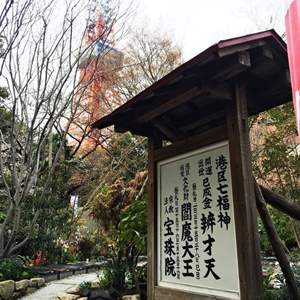 6.Houju-InThe Sunomi I of Zojoji Temple of the Jodoshu temple is founded in 1685 in the second year as a separate temple, with the King Enma and the dialectic-year-old angel of the white hasuike. The Benzaiten, which has become one of the seven lucky gods of the port, received the adoration of the sculpture, the Genyorasa and Tokugawa Ieyasu in the Takeko Island in 858 when the Kimiidera founder. The Enma king statue of the Minato-ku important cultural property is enshrined.Directions
6.Houju-InThe Sunomi I of Zojoji Temple of the Jodoshu temple is founded in 1685 in the second year as a separate temple, with the King Enma and the dialectic-year-old angel of the white hasuike. The Benzaiten, which has become one of the seven lucky gods of the port, received the adoration of the sculpture, the Genyorasa and Tokugawa Ieyasu in the Takeko Island in 858 when the Kimiidera founder. The Enma king statue of the Minato-ku important cultural property is enshrined.Directions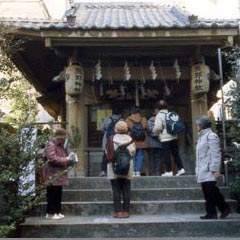 7.Iikura Kumano ShrineIt is said that the solicitation and auspiciousness of Kumano Shrine is unknown because the old records were destroyed in a fire in the 16th year of Genroku. It seems that the number of people who visit Kumano Shrine has increased because the three-legged Yatagarasu has become the symbol of the J.League, and it is said that there are more family members and supporters than the players themselves. The official "Soccer Guard" of the Football Association is white and blue. It shows its presence with Ebisu's clay bells. One of the seven lucky gods of Minato Ward, Ebisu-sama, is enshrined. Ebisu holds a fishing rod in his right hand and a sea bream in his left. Originally, it was a fisherman's god and was worshipped as a god that brings good fishing and safe navigation. As commerce flourished, he came to be worshipped as the god of business prosperity. According to Shimazaki Fujimura's "Around Iikura" when he lived in Iikura, this area was a very good walking path and was one of Fujimura's favorite places.Directions
7.Iikura Kumano ShrineIt is said that the solicitation and auspiciousness of Kumano Shrine is unknown because the old records were destroyed in a fire in the 16th year of Genroku. It seems that the number of people who visit Kumano Shrine has increased because the three-legged Yatagarasu has become the symbol of the J.League, and it is said that there are more family members and supporters than the players themselves. The official "Soccer Guard" of the Football Association is white and blue. It shows its presence with Ebisu's clay bells. One of the seven lucky gods of Minato Ward, Ebisu-sama, is enshrined. Ebisu holds a fishing rod in his right hand and a sea bream in his left. Originally, it was a fisherman's god and was worshipped as a god that brings good fishing and safe navigation. As commerce flourished, he came to be worshipped as the god of business prosperity. According to Shimazaki Fujimura's "Around Iikura" when he lived in Iikura, this area was a very good walking path and was one of Fujimura's favorite places.Directions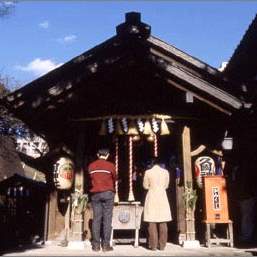 8.Kunkoku ShrineThe Kukoku shrine is enshrined the god of Fukutoku harmony. It is respected as "Kukuni Inari Daimyojin" because the donated of the Treasure Sword of the NIT and Hisakuni work in the Kamakura period. In addition, the forehead of the front front shrine is assumed to be the one by the brush of Katsukaifune. He is the only real person in the seven Lucky Gods and a priest. I wore a petite, pot belly, torn robe and always had a big bag. In the bag, everything needed for daily life was included. It is said that it is good to foresee the fortune-telling and the weather, and the body did not get wet even if sleeping in the snow. Moreover, it is said that it is an incarnation of Maitreya, and it is called a sack-sama in China today.Directions
8.Kunkoku ShrineThe Kukoku shrine is enshrined the god of Fukutoku harmony. It is respected as "Kukuni Inari Daimyojin" because the donated of the Treasure Sword of the NIT and Hisakuni work in the Kamakura period. In addition, the forehead of the front front shrine is assumed to be the one by the brush of Katsukaifune. He is the only real person in the seven Lucky Gods and a priest. I wore a petite, pot belly, torn robe and always had a big bag. In the bag, everything needed for daily life was included. It is said that it is good to foresee the fortune-telling and the weather, and the body did not get wet even if sleeping in the snow. Moreover, it is said that it is an incarnation of Maitreya, and it is called a sack-sama in China today.Directions- GOAL



